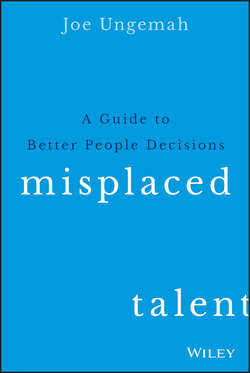Читать книгу Misplaced Talent - Ungemah Joe - Страница 5
На сайте Литреса книга снята с продажи.
Chapter 1
Frameworks
ОглавлениеWithout having job criteria in place, there is simply no way of predicting with any degree of confidence whether your people decisions are fair and rational. Practitioners rely on job descriptions and talent management frameworks to combat the risks of poor people decisions, because when you start racking up all the direct and indirect costs of an unfilled vacancy or a poorly placed new hire, the costs are striking, especially for roles that are core to the business.
One of my clients put its business analytics team to the task of figuring out how much it costs to replace a front-line employee. These are not high level positions, but rather staff working in retail branches and call centers. By the time the analyst calculated the cost of advertisement, the time spent by the recruitment team to screen and interview candidates, the loss of productivity because the role was vacant, and the cost to induct a new employee, the total figure was a staggering $57,000 per vacancy.
You might be skeptical and think this sounds too high, but even if you accept that the cost is only half as high, the damage of hiring the wrong people or failing to address engagement issues are substantial. When you consider that an annual turnover rate of 30 percent is the norm for certain industries, a modest improvement in retention (i.e., people staying on for a few extra months on average) can save a large organization millions of dollars and potentially gain a few customers along the way, through a more positive customer experience with an engaged company representative.
Before employees can be hired or money spent on development, practitioners must establish criteria about what they are trying to accomplish. For recruitment, identifying critical skills and experiences ensure that they hire the candidate most likely to perform well on the job. For development, understanding what needs to be improved and for what reason can ensure that training budgets are invested wisely.
This chapter is devoted to exploring the frameworks put in place by practitioners to help guide people decisions throughout their organization. By defining what the employee and organization, respectively, bring to the table, as well as the glue that holds them together, it is hoped that decisions can be made by their collective ability to strengthen the employment relationship.
The chapter begins by charting the origins of job analysis and the subsequent change in emphasis from the division of labor to the drivers of employee performance, followed by the rise of behavioral competencies as the language practitioners use to define the workplace. We will then look at the complexities of defining a structure that works effectively across levels, functions, and jobs, as well as two of the common applications for talent management frameworks in recruitment and development.
I aim to demonstrate that there exists an inherent tradeoff between defining a framework that accounts for the intricacies between jobs and its usefulness for making sound talent management decisions. The role of the practitioner is to use his or her best judgment in weighing the pros and cons of each alternative, settling on the framework that will have maximum utility for the organization at this specific point in time. Right now, I believe that the pendulum has swung too far, with frameworks accounting for only a fraction of the employment relationship (focusing excessively on behaviors) and applying generic language across highly divergent roles. Together, these trends provide practitioners with the greatest opportunity to help their organizations reframe what top talent looks like.
